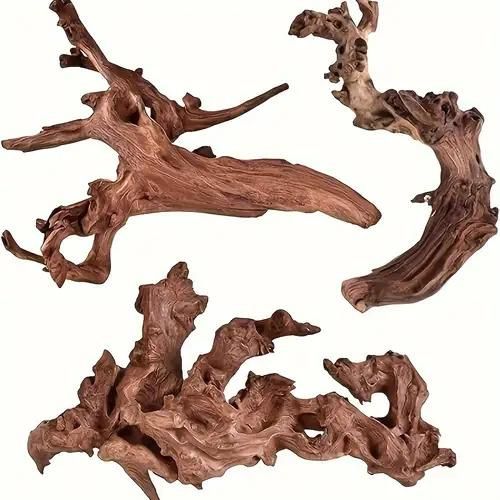Discover the key factors to consider when selecting driftwood for your aquarium and create a stunning underwater landscape.
Understanding the Importance of Driftwood in Your Aquarium
Driftwood is not only a beautiful addition to your aquarium, but it also serves a vital purpose in creating a natural and healthy environment for your aquatic pets. In the wild, driftwood is found in rivers, lakes, and oceans, and it provides shelter, hiding spots, and a source of food for various aquatic organisms. By adding driftwood to your aquarium, you can replicate this natural habitat and enhance the overall well-being of your fish and other aquatic creatures.
One of the key benefits of driftwood is its ability to release tannins into the water. These tannins give the water a natural brownish color, similar to the water in many natural habitats. This not only adds visual appeal to your aquarium but also creates a more natural and comfortable environment for your fish. Additionally, the tannins have antibacterial properties that can help prevent diseases and promote the overall health of your aquatic pets.
Another important function of driftwood is its ability to lower the pH level of the water. Many fish species, especially those found in tropical regions, prefer slightly acidic water. By using driftwood in your aquarium, you can create the ideal pH level for your fish and encourage their natural behaviors and breeding patterns. It's important to note that not all fish species require acidic water, so it's crucial to research the specific needs of your fish before adding driftwood to your aquarium.
Types of Driftwood: Aesthetics and Functionality
When it comes to choosing driftwood for your aquarium, there are various types to consider, each with its own unique aesthetics and functionality. Some popular types of driftwood include Mopani wood, Malaysian driftwood, and Spider wood.
Mopani wood is known for its dark brown color and intricate branching patterns. It provides a dramatic and visually striking focal point in your aquarium. Malaysian driftwood, on the other hand, has a lighter color and a more twisted and gnarled appearance. This type of driftwood is great for creating a natural and rustic look in your aquarium. Spider wood, as the name suggests, has thin branches that resemble spider legs. It adds a unique and intricate element to your aquascape.
Malaysian driftwood is a popular choice for aquarium enthusiasts due to its unique and rustic appearance. With its lighter color and twisted, gnarled appearance, Malaysian driftwood adds a natural and organic touch to any aquarium. Not only does it enhance the aesthetics of your underwater landscape, but it also serves a vital purpose in creating a healthy environment for your aquatic pets. Malaysian driftwood releases tannins into the water, giving it a natural brownish color and creating a more comfortable and natural habitat for your fish. These tannins also have antibacterial properties, promoting the overall health and well-being of your aquatic pets. When choosing Malaysian driftwood, it's important to consider the size and shape that will best fit your aquarium and the specific needs of your fish. Additionally, proper preparation and maintenance are crucial for the longevity and functionality of the driftwood in your aquarium. By selecting Malaysian driftwood and taking the necessary steps to care for it, you can create a stunning and natural underwater landscape that will captivate both you and your aquatic pets.
Spider wood, also known as Manzanita wood, is another popular choice when it comes to selecting driftwood for your aquarium. It is characterized by its slender and twisted branches, which resemble spider legs, hence the name. Spiderwood adds a unique and intricate element to your aquascape, creating a visually stunning underwater landscape. Not only does it enhance the aesthetics of your aquarium, but it also serves a functional purpose. Like other types of driftwood, spiderwood releases tannins into the water, giving it a natural brownish color and creating a more comfortable and natural habitat for your fish. The tannins also have antibacterial properties that can benefit the overall health of your aquatic pets. When choosing spiderwood, consider the size and shape that will best fit your aquarium and the specific needs of your fish. Proper preparation and maintenance are crucial to ensure the longevity and functionality of the spiderwood in your aquarium. By selecting spiderwood and taking the necessary steps to care for it, you can create a captivating and natural underwater landscape that will be the envy of other aquarium enthusiasts.
When choosing driftwood, it's important to consider both its aesthetics and functionality. The size and shape of the driftwood should be compatible with the size of your aquarium and the specific needs of your fish. It should also provide ample hiding spots and resting areas for your aquatic pets. Additionally, make sure to select driftwood that is safe for aquarium use, as some types of wood may release harmful substances into the water.
Factors to Consider when Choosing Driftwood
There are several factors to consider when choosing driftwood for your aquarium. First and foremost, you should consider the size of your aquarium and the available space for the driftwood. It's important to choose driftwood that fits well within your aquarium and doesn't overcrowd the space.
Another important factor to consider is the type of fish and other aquatic creatures that will be living in your aquarium. Different species have different preferences when it comes to driftwood. Some fish may prefer larger driftwood pieces with plenty of hiding spots, while others may prefer smaller pieces or even driftwood caves. Research the specific needs of your fish and choose driftwood that can accommodate their requirements.
Additionally, consider the water parameters of your aquarium. As mentioned earlier, driftwood can lower the pH level of the water. If you have fish that prefer slightly acidic water, driftwood can be a great addition. However, if your fish require neutral or alkaline water, it's important to choose driftwood that will not significantly affect the pH level.
Lastly, consider the overall aesthetics of the driftwood. Choose pieces that complement the theme and style of your aquarium. Driftwood can add a natural and rustic touch, or it can create a more dramatic and eye-catching centerpiece. The choice is yours!
How To Prepare Driftwood for Aquarium Use
Before adding driftwood to your aquarium, it's important to properly prepare it to ensure the health and safety of your aquatic pets. First, make sure to thoroughly clean the driftwood to remove any dirt, debris, or potential contaminants. Scrub the driftwood with a brush and rinse it well with clean water.
Next, it's recommended to soak the driftwood in water for several days to leach out any tannins or other substances that may discolor the water or affect the pH level. You can use a clean bucket or container filled with water for this purpose. Change the water daily until it remains clear, indicating that the driftwood is ready to be added to your aquarium.
If you prefer to accelerate the process, you can also boil the driftwood for a few hours. This helps to remove tannins and other impurities more quickly. However, boiling may cause the driftwood to become waterlogged, so it's important to let it dry thoroughly before placing it in your aquarium.
Once the driftwood is clean and free of any potential contaminants, you can carefully arrange it in your aquarium. Take into consideration the needs and preferences of your fish, and create a layout that provides ample hiding spots and swimming areas. Secure the driftwood in the substrate or use aquarium-safe glue or fishing line to keep it in place.
Maintaining Driftwood in Your Aquarium
Once the driftwood is in your aquarium, it's important to properly maintain it to ensure its longevity and functionality. Regularly inspect the driftwood for any signs of decay, rot, or damage. If you notice any issues, remove the affected parts or replace the driftwood if necessary.
To prevent the growth of algae or other unwanted organisms on the driftwood, it's recommended to periodically clean it. You can gently scrub the driftwood with a soft brush or toothbrush to remove any algae or debris. Avoid using any harsh chemicals or cleaning agents, as they can be harmful to your aquatic pets.
It's also important to monitor the pH level of the water and make any necessary adjustments. Depending on the type of driftwood and the needs of your fish, you may need to supplement the water with chemicals or additives to maintain the desired pH level.
Lastly, consider the placement of the driftwood in your aquarium. Over time, the driftwood may shift or become dislodged, especially if you have active fish or strong water currents. Regularly check the position of the driftwood and make any necessary adjustments to ensure it stays securely in place.






Leave a Comment